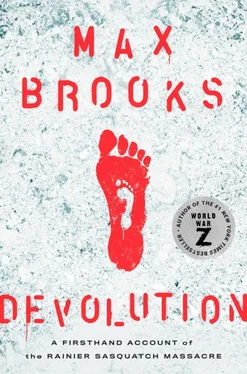I turned back for home, stopping as Dan came out of the Boothes’ house to do his roof cleaning. He saw me, waved, and even blew me a kiss that I returned. For a moment, I considered staying, to help or just to keep him company. Something about him being outside all alone. I didn’t like it anymore. I felt, feel, uneasy.
Everything’s too still. No wildlife. No sound. But the smell. It’s constant now, like it followed us down from the kill site. And the eyes. I didn’t feel like I was being watched this morning. Maybe I was just too focused on the dead cat. But I feel them now. Walking home, I kept looking up and around me. Up to the ridge above the houses, scanning the trees. I didn’t see anything, but does something see me? That’s why I couldn’t wait to get inside. That’s where I am now, sitting on the couch, keeping an eye on Dan through the living room window. Blissfully scraping those panels, then jumping back from the falling ash like it’s a game.
I don’t mean to keep glancing up at the woods. I’m trying not to memorize every tree, rock, patch of open space, to see if any of them change between glances. I’m trying really, really hard not to head back over to the Boothes’ to see if they have binoculars. With all their hikes, they must have a pair. I’ll be going over there for more compost, or staying home to work in the garden, something other than watching Dan out there by himself. I thought about getting in the car to listen to the news. But the car faces the house.
I don’t want my back turned.
From Steve Morgan’s The Sasquatch Companion.
The official history of cryptid hominid encounters has had, shall we say, a checkered relationship with indigenous oral evidence. In the words of J. Richard Greenwell, secretary and founder of the International Society of Cryptozoology, “Native peoples tend to not have a very clear line of demarcation between the metaphysical world and the physical world. We in the West very clearly separate those.” [23] Interview from the History Channel’s In Search of History, 1997.
This is obviously a heavily biased and debatable point of view, especially when so many “Western” (i.e., Caucasian) eyewitnesses claim to have seen supernatural, even extraterrestrial, elements associated with Sasquatch. Nevertheless, Greenwell’s statement typifies a substantial reliance on a Eurocentric record of encounters, a record that until the mid–twentieth century was woefully lacking.
Given the chaotic, often competitive nature of Europe’s American invasion, and the incurious, illiterate nature of so many individual invaders, it is a wonder that any written accounts emerged from this period. While there are, of course, notable exceptions such as Fred Beck’s Ape Canyon Siege, Roosevelt’s “Goblin” story, and the writings of British explorer David Thompson, who discovered “the track of a large animal” which “was not that of a bear,” we simply cannot know how many trappers, traders, and gold-fevered prospectors took their Sasquatch experiences to the grave. For all we know, some modern-day Russian may have a mysterious, malodorous hide nailed to the wall of his dacha that his ancestor brought back from the tsar’s American colony.
So why the change? Why did contact with Sasquatch suddenly go from a trickle to a flood? The answer is simple: World War II. Before this cataclysmic event, fewer people (of all ethnicities) lived between Northern California and the Canadian border than lived in New York City. With Pearl Harbor came industry, military installations, infrastructural expansion, and millions upon millions of Americans. Small wonder that, barely thirteen years after V-J Day, in Bluff Creek, California, [24] Bluff Creek is also known as the site of the 1967 “Patterson film” of Bigfoot.
a road construction crew discovered what appeared to be strange, giant, humanoid tracks. This discovery prompted the investigation by a local newspaper, which, in turn, unearthed previous stories from the surrounding area.
By the end of the year, the tracks had made headlines around the country, along with a name for their creator: Bigfoot.
Chapter 10

Eyewitness testimony in the case of Bigfoot… ahhh… I don’t think is very good because you can’t test it. It’s… it’s the credibility of the person… and these people… they want to see something strange… they can imagine it.
—DR. THOMAS DALE STEWART, former head curator of the Department of Anthropology for the Smithsonian Institution
From my interview with Senior Ranger Josephine Schell.
Why haven’t they been found? That’s the ninety-nine-thousand-dollar question. And my two-cent answer is timing. See, the people in a position to prove their existence, who know how to find and analyze physical evidence, they won’t go anywhere near it for fear of ruining their reputations. And that fear goes back to the time when Sasquatch first came to light.
If we’d had a rash of sightings way back in, say, the ’40s and ’50s, when we were still a cohesive nation with shared beliefs, maybe there would have been enough traction to force the scientific community to act. And if they had, if they’d proven these creatures are as real as the gorilla or chimpanzee, icons like Dian Fossey or Jane Goodall might have built their careers studying the great apes of North America.
The problem was that sightings peaked in the late ’60s, early ’70s, which was, coincidently, the dawn of public mistrust. We’re talking Vietnam, Watergate, “do your own thing” counterculture. Now, I’m not saying any of that was bad, especially in a democracy. You need a healthy degree of critical thinking. You need to question authority. But Bigfoot came along just as everyone started questioning everything, including academia. This was a time when university profs were getting hit from both sides; the right with their creationist agenda, and the left who’d suddenly realized the connection between science and war. The upshot was that already cautious PhDs got even more skittish about their grants and tenure.
Which led them to drop Bigfoot right into the “crackpot” files. Where it has stayed till… yeah… till this day… even with what’s happened… which we’ll get to.
There’s a big reason Uncle Sam hasn’t released a full report on Greenloop. But…
Holds out her hands like a traffic cop.
“One thing at a time,” as Ms. Mostar said.
Point is, public skepticism dissuades qualified experts from searching for physical evidence, and lack of physical evidence only fuels public skepticism.
Which is why the burden of proof has been mainly left to amateur adventurers who either never find anything or make it worse for themselves like that time with the FBI. [25] In June of 2019, under the Freedom of Information Act, the Federal Bureau of Investigation released a twenty-two-page file detailing its laboratory analyses of hair “attached to a tiny piece of skin.” The sample, brought to them in 1976 by the Bigfoot Research Center, was determined to be “of the deer family in origin.”
You know about that, right? Came out a couple years ago? Some whack-job group in the ’70s pressured the Bureau to test a hair sample they collected and the sample turned out to be a deer. And it’s those kinds of public, Al Capone–vault fiascoes that keep credible eyewitnesses from going public. And I’ve talked to more than my share of eyewitnesses. In this job, you get a lot of folks who are sure they’ve encountered something. Not hoaxers. They don’t come to us. They go to the media. That’s where the money is, and fame. All that shaky footage that shows up every now and then. The most famous one, the “Patterson-Gimlin film” that gave us the image most people associate with Bigfoot… Roger Patterson claimed he was out there getting ready to make a Bigfoot movie and just “happened” to run into the real thing. Really?
Читать дальше






![Traudl Junge - Hitler's Last Secretary - A Firsthand Account of Life with Hitler [aka Until the Final Hour]](/books/416681/traudl-junge-hitler-s-last-secretary-a-firsthand-thumb.webp)






